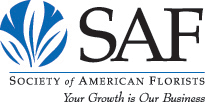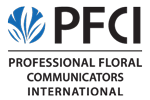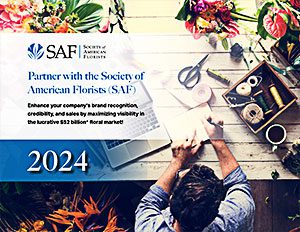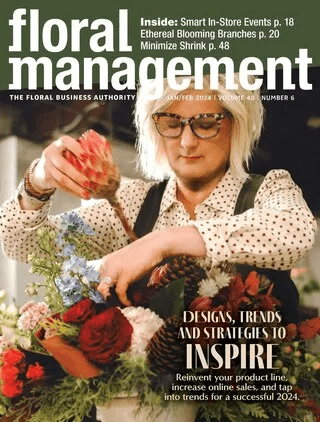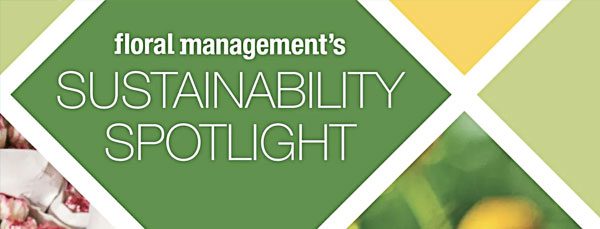A 12-Step Guide to Organizing
Programs that Educate, Motivate
and Captivate
Dedication: by Alan Parkhurst, AIFD, PFCI
Dedication: by Alan Parkhurst, AIFD, PFCI
What does it take to host a successful event?
Ask a dozen of the industry’s top show planners and you’ll get a dozen answers. That’s exactly what we have done in “Successful Events: Your Guide to Organizing Programs that Educate, Motivate and Captivate.”
In this step-by-step guide, you’ll find ideas and suggestions from professional floral industry speakers as well as wholesalers who host programs. They’ve seen it all, but agree that the one thing they don’t ever want to see are empty seats — except when the audience is on their feet cheering or buying products.
Not every event is alike, so take a few ideas from one section and a couple from another, and you will have a nice combination of tips and tricks to achieve great results.
This Guide began in the mid 1980s as “The Wholesaler’s Survival Guide: A Checklist for Staging Successful Open Houses & Design Schools.” It was expertly written by the PFCI trustees of the time:
- Lynn Lary McLean, AAF, AIFD, PFCI, TMF
- James Bridenbaugh, AAF, PFCI
- Wilton Hardy, AAF, AIFD, PFCI
- Ralph Null, AAF, AIFD, PFCI
- Rocky Pollitz, AAF, AIFD, PFCI
- Dwight Matsuno, AAF
We are grateful to them for their vision, originality and content.
While this Guide focuses on helping wholesalers, we’ve added new and broader show information so that any association, wholesaler, florist or individual will have impeccable results when planning, executing and presenting a floral show. Several PFCI members and wholesalers made valuable contributions to this text:
- Marie N. Ackerman, AAF, AIFD, PFCI
- Carol Caggiano, AIFD, PFCI
- Jeffrey D. Corbin, AAF, AIFD, PFCI
- Tina Rojahn Elsafy
- Bob Luthultz, AAF
- Arlene Sorensen
I also want to thank the staff of the Society of American Florists and the SAF Wholesalers Council for their expertise. Working with SAF is an experience of working in cooperation with all facets of the industry, and this Guide is a prime example.
Enjoy the results.
Alan K. Parkhurst, AIFD, PFCI
Chairman, 2004 PFCI Board of Trustees
Step 1: Set Goals
Every successful event demands clear goals. Take the time to write yours down. Ask yourself, “Why am I you holding the event?” Is it:
- A selling tool to gain more customers?
- A new product launch?
- For customer appreciation?
- Unveiling new personnel or services?
- To build customer loyalty?
- All of the above?
Share the event goals with staff and the presenters you select.
Don’t rely on luck to bring about the anticipated results. Go into a program knowing exactly what you want your audience and your business to walk away with.
Once you’ve decided, keep these realistic goals in sight as you plan. Too often, original goals become lost due to lack of planning, excessive planning, lack of time and/or miscommunication.
Step 2: Select a Theme
The theme may be as simple as a seasonal design show or as elaborate as a bridal spectacular. Perhaps the focus is a bottom-line topic, such as marketing, selling or pricing. Create a logo and catchy headline to name the program — use it on all brochures, fliers and other promotional materials. Write a brief paragraph describing the program that can be used for promotional purposes.
Step 3: Choose the Format
There are many types of programs. Today’s trend favors Demonstration, using one speaker who can do it all — educate, design, commentate and entertain. Some symposium programs are still popular, but demonstration of techniques should be included in a symposium program, especially for the purposes of education and sales. Here are the most popular show formats:
Demonstration, Lecture or Panel
Designed for conveying large amounts of information in a casual format, this type of program is for laid-back audiences. Some designs may be created in advance – others in front of the crowd. There is plenty of time for questions and the program is geared to what the audience wants. Once again, this format requires a designer who is a good speaker and a good designer – and fairly quick on their feet.
Symposium
The designer/presenter has created arrangements prior to the show and speaks about their work on stage. Book designers who can make beautiful things and speak eloquently. Programs often incorporate the designer creating one or two designs on stage or “finishing” them in front of the audience. There is usually more than one program in a full-day event, each presented by different designers.
Symposium programs can be more about theory and concepts — and are inspiring to many audiences. This is when two or more designers are on stage creating designs. Many audience members, especially new designers, want to see designs created in front of them, because they comprehend better if they see the design construction. There are many things going on in a show like this — and to many, this type of program is exciting. A commentator explains the designs after they are completed.
For more information on Symposiums, read Lights! Camera! Action! Notes for Presenting a Stage Program by Rich Salvaggio, AAF, AIFD, PFCI, CAFA.
Extravaganza
Expensive to produce, the Extravaganza show can establish your business as a design leader. It often features runways, models, music, lighting and even costumes. This type of show can be more entertainment and style than education.
Step 4: Set the Date
Check the calendar carefully when choosing dates. Keep in mind holidays that could cut attendance, and avoid dates that conflict with established local and national floral events. Fall and winter holiday programs and open houses are being held as early as July to enable florists to buy early, organize displays and manage sales with time for repeat orders.
Some florists prefer weeknight programs, usually a Tuesday or Wednesday evening, while others prefer the traditional Sunday program. Ask customers when they would most likely support a program. Try both types in one year and measure the results. Ask other wholesalers or show sponsors what works best for them.
Sundays
- Consider the distance customers travel when setting start times.
- If the program is Sunday morning, avoid starting too early.
- For some florists, it is their only day off; so they may skip an early event.
- Some florists attend church on Sunday mornings; historically, most programs start between 9:30 and 10 a.m. on Sunday.
- Make sure events don’t run too late. Most florists want to be on their way home no later than 4 p.m. In some areas, 3 p.m. is the maximum due to long commutes.
Weeknights
- Consider traffic in your area.
- Ideally begin with an open house, shopping event or serve food about one hour before a program starts.
- Some successful wholesalers tell customers to come early between 4:30 and 6 p.m. to eat and shop, and then run the program from 6 – 8:30 p.m. with a break from 7-7:30 p.m.
- Weeknight programs should end by 9:30 p.m. Florists are early risers and have been on their feet all day. Plus, parents want to get home to tuck in their children.
Step 5: Establish a Budget
A budget is a necessity for managing an event properly. It must cover all expenses to produce a successful show and reach your goal. Too often a poorly planned program runs over budget as last-minute details are approved in haste. A carefully planned and executed event can be kept within budget. Once a budget has been determined, make sure that every person responsible for planning the program is aware of it. CLICK HERE for a Sample Budget (XLS).
Count Products Used
Decide your internal accounting and bookkeeping issues as they relate to product used in the show. Arrange for a process that does not slow designers or presenters. If the process is too lengthy, the designers will be bogged down in your internal bookwork and unable to produce the number of designs for the proper presentation you deserve.
To keep track of products designers use in show pieces, give designers a brown bag to use for each design. As they use product, designers simply throw the products’ price tags into the brown bag. Successful wholesalers usually assign a member of their staff to record product and pricing that the designers use.
Charge a Fee
Wholesalers should charge a fee to help cover expenses. Decide what your admission price will be and clearly state it in all advertising. To encourage florists to commit early, provide an early-bird registration fee. For example, charge $10 or $15 in advance. At the door, charge $15 or $20. You may want to consider providing complimentary admission to top customers. Tell top customers in invitations: “Because you’re special to us, we’d like to offer you a complimentary ticket.” If you decide not to charge admission, avoid the word “free” in promotions. “Free” events are often perceived to have no value. Use the word “complimentary” instead.
Step 6: Hire the Experts
Communicators/Educators
If you’re selling quality products, be sure you have a quality educator. Communicators should be versatile. They should be able to work with a design panel in front of an audience. Knowledge of product promotion, sales techniques and general industry knowledge are musts. Commentators can produce results, both positive AND negative. A good commentator will make your show a success.
Things to keep in mind when selecting a commentator:
- Track record in the industry
- Qualifications to conduct the type of program you are planning — whether it is a wedding show, sales and business, general product promo or entertainment-oriented
- Personal speaking style
Advance planning and written confirmation from either the commentator or sponsoring company will avoid disappointment. Click here for a Sample Confirmation Letter. You should book a quality speaker 90 days to 1 year in advance.
Need a Speaker?
SAF’s Professional Floral Communicators – International (PFCI) is the resource to find an experienced commentator. PFCI members are well-versed on subjects from design and shop management to care & handling and holidays. They have been evaluated on their presentation skills, floral and industry knowledge, expertise and experience. Most PFCI members are also skilled designers as many are members of the American Institute of Floral Designers (AIFD). Visit the PFCI Membership Directory for a listing of PFCI members by name, state and expertise.
Another way to know if someone is a quality speaker is to ask others. At the SAF convention, ask wholesalers and retailers if they’ve seen any good speakers. Go to the Wholesale Florist & Florist Supplier Association (WF&FSA) events and ask wholesalers what speakers they recommend.
Designers
Don’t wait until the last minute to secure a designer; competent designers are difficult, sometimes impossible, to obtain on short notice. Certain times of the year, such as March and September, create heavy demand for top designers. Plan accordingly: 90 days to 1 year notice is preferred by many of the industry’s most sought-after designers.
If your event is primarily a product showcase, it is essential to have designers that know how to promote your merchandise profitably, and who are versatile and creative artists.
You might be put in the position of having an untried, unproven designer’s services made available; use caution and discretion at this point, as a weak designer is a bad choice in the long run and can even affect your reputation as the host. It cannot be stressed often enough — know the capabilities and background of your designers.
A good place to meet designers is through the American Institute of Floral Designers. Each year, the AIFD National Symposium draws hundreds of the industry’s most talented designers. The Symposium is held every year during the week of July 4th. You can also search for AIFD designers at www.aifd.org.
Design Manager
Consider your supply manager as chair of the design program since a good deal of merchandise will come from the supply department. The supply manager may help secure designers sponsored by some of the companies that supply items for your business. They have the contacts that can help save you some out-of-pocket expenses. Selecting designers should be based on cost, topics of local interest, skill set and geographic location. Be sure to talk to your design manager about inventory to avoid lots of open boxes with little product used.
Sponsorships
Sponsorships can be a “win-win” for both you and the sponsor. Many industry companies (product suppliers, manufacturers, wire services) will gladly support your program. They have a team of talented designers they use specifically for this purpose. Some companies also have funds available to help you sponsor your preferred speaker and/or designer(s). This can result in significant savings to your program budget.
If you are seeking sponsors for designers or commentators, start early. Some organizations require 90 days to 1-year to finalize the details of booking a designer or commentator to do your event. Find out the rules early and work them into your show timeline. Ask about rules regarding their sponsorship and abide by them. Be sure to talk to the sponsor about whose responsibility it is to pay the speaker and designers.
Exhibitors
The time that you’re securing commentators, designers and sponsorships is also the time you could sell exhibitor space. Your suppliers and favorite industry associations might be interested in displaying their products during your event. It gives them an opportunity to showcase the products that you carry, and it gives you additional revenue.
Script
Once you’ve confirmed your designers and commentators give them the tools they need, including, but not limited to:
- A list of products to promote (photos if available)
- Pricing. When an audience member asks, “How much does the design cost,” they are really saying: “Tell me how to price my designs profitably.” How should your commentators and designers handle questions on pricing? Do you want them to take a guess at the price from stage? Do you want them to explain the method of calculating a selling price with markups and labor charges? Deal with the subject of pricing in advance, and the presenters will handle it the way you want it. And be sure they remind customers about the SAF Retail Pricing Worksheet. The Worksheet is an easy way to calculate the cost of goods sold.
- Show goals/objectives
- Schedule, including slots for other presenters, and breaks for customer shopping, rest and meals
Fee
Many variables affect the fee paid to commentators and designers — experience, length of actual stage time, show requirements (judging contests, auctioning designs, conducting hands-on seminars), and prep and travel time required.
In general, rates range from $350 to $1,000. These rates do not include travel expenses (airfare, mileage, food and lodging).
Most presenters have established rates. Tell the presenter exactly what you need (stage time and prep time), and ask them for a quote. Most are paid the same fee for prep and stage time. You may want to negotiate a flat fee for all services, which covers prep and show day. Agree in advance when the fee is paid. Most presenters prefer to have their check at the conclusion of the program, before they leave the show location.
The Contract
You should provide a contract to the designers and commentators. Contracts protect your show by getting the designer’s/presenter’s commitment in writing. Something as simple as a letter containing the dates the person is required to work, approximate hours, lodging information, show hours, show topic or topic specific to that presenter, fee structure and cancellation fee. Click here for a Sample Confirmation Letter.
Many successful wholesalers establish their expectations in writing with each presenter upon confirmation and then follow up again with the same information 30 days before the show. You should also verbalize your expectations before the show begins.
Be sure to have your design expectations in writing. This means how many and the types of arrangements that should be created and at what average price points.
“Care & Handling” of Presenters
Most designers and commentators who are on the “circuit” appreciate your hospitality as the show’s host. While presenters are your employees, they should be treated as guests. However, they do not expect to be “wined and dined” with lavish meals and limousine rides.
They do however appreciate a ride to and from the airport (or clear directions to your location and the hotel if they are driving) — good food offered at the appropriate meal times and a heartfelt “thank you” at the show’s end.
If you are looking for ways to go “the extra mile” for your presenters, you may consider having a small welcome basket or flowers waiting in their hotel room, or a small easy to pack gift at the program’s conclusion. Ideas include a floral design book or even a gift card for a book store, music store or variety store.
Step 7: Hook Up the A/V
Be sure the correct audiovisual equipment the presenter has requested is available upon their arrival. Also be sure you have accounted for the cost of these rentals in your budget.
Projectors
Overhead projectors, 35mm slide projectors and LCD projectors could be among the requests made by a presenter. If the presenter wants to use PowerPoint, ask if they are bringing their own laptop computer, and then rent an LCD projector. Renting the equipment to use PowerPoint can be expensive — but it is an ideal way to effectively communicate a complex message.
Audio Equipment
Select the very best sound system. Do not wait until the last minute to secure equipment. A little homework goes a long way. You might be able to borrow audio equipment from another wholesaler, a school or a local organization. If you can’t borrow one from a friend, visit an audio rental place.
You will need at least:
- 2 speakers
- Speaker stands
- A cordless microphone (base unit and battery pack)
- Mixer board
Often the rental company will set up the equipment for you. You can add a tape deck or CD player if you would like to have background music. Consider background music for breaks, as well as before and after the program.
Microphones
- Lapel/Lavaliere: A lapel microphone is preferred by most commentators. You should provide a cordless lapel lavaliere microphone for the presenter.
- Handheld: A handheld microphone is not very effective for the presenter, but could be a good investment for announcements or introductions at the show’s opening and closing. If you must go with a handheld for the entire program, choose a cordless one. Otherwise, be sure that it has a cord long enough for mobility (at least 50 feet).
- Headset: Used by music groups and people doing demonstrations, headsets are inexpensive to rent and have a high quality of continuing sound.
Find out your commentator’s preference in advance. Connect and test the sound system before you open the doors so that any malfunction or less-than perfect condition can be corrected before guests arrive.
Also, many cordless microphones have battery packs – be sure to have extra batteries on hand at show time.
Silence is Golden
Be sure that you and your staff do not disturb the program by talking while the show is in progress. It’s natural to want to chat with your best and friendliest customers, but it is not conducive to providing a quality program.
- If you must speak to someone, escort the person completely out of voice range.
- Instruct employees to be polite but persuasive about maintaining the integrity of the show.
- If your refrigeration or delivery systems make loud noises, arrange to curb them during the program. Turn them back on if necessary for breaks, meals and shopping times, but try to keep all ambient noise to a minimum.
Step 8: Promote the Event
Evaluate the promotional necessities, keeping in mind that you must demonstrate to customers what they will gain by coming to your event. Sale items, price leaders and specials are worthwhile attention getters. When it comes to getting your message out, you have options:
- Traditional direct mailings:
Invitations
Postcards
Personal letters
Statement stuffers
- Social Media – Facebook and Twitter
- Hand-delivery
- Phone calls
- Phone system’s on-hold message
If working with a sponsor, ask if the sponsor has direct mail or promotional procedures.
Direct Mail
Direct mail can be as elaborate or as simple as your budget permits, but should be in the form of a self-mailer. Busy florists often do not open envelopes. Distribute mailers four to six weeks before the event so that customers and guests can plan to attend. If you mail invitations too soon, florists may put it aside and forget about it. If it arrives too late, they may not have time to plan. Sending a follow-up reminder in the form of an e-mail or postcard is also a good idea.
Promotions should list:
- The name (or title) of event
- Name of wholesaler
- Complete address, e-mail address and website
- Phone number
- Date and time of event
- A schedule that includes start and end times
- Purpose
- Special sales information
- Design panel members and commentator if it is to include a design program
- Sponsor(s)
- Exhibitor(s)
- Directions
- Parking information
- Admission Fee
- Refreshments if provided
If you do not have the experience to estimate attendance, consider asking attendees to RSVP. RSVP’s make people feel committed. Although replies won’t provide exact numbers, they do give a better sense for planning seating, refreshments and other details. An early-bird registration fee encourages RSVP’s.
You may want to consider a no refund policy and print “No Refund” on admission tickets.
If you can afford a full-color flier or brochure, consider continuing the color theme throughout the event.
And, if a customer does not attend your event, send a note: “You’re a valued customer, and we noticed you weren’t at our show. We hope everything is OK.” Little touches like this go a long way in building loyalty.
Keep an updated list of your customers’ e-mail addresses so you can send informational updates. It’s also a quick and efficient way to get RSVP’s.
Word of Mouth
Don’t forget word-of-mouth advertising. Your employees’ enthusiasm can generate interest and increase program attendance.
- Sales staff and drivers should distribute extra mailers.
- Drivers can handout fliers to shop employees when they make deliveries.
- Sales staff can offer invitations during sales calls.
- Some wholesalers assign staff to make direct contact with retailers. That extra effort goes along way to show that you’re personally inviting them makes customers feel very flattered. Call about a week or two before the show. Keep the conversation light and casual. No pressure: “We’re just wondering if you’re available to attend. Will you join us?” Use this opportunity to tell customers more about the program, such as who the designers are and what’s on the dinner menu.
- If your budget allows, consider advertising in area trade journals.
- Promote your program with signage for walk-in customers to your wholesale location.
Step 9: Boost Morale
Employee attitude is critical to the success of your event. A lot of physical and emotional effort is required to prepare for guests, and sometimes an exhausted crew simply cannot muster the enthusiasm necessary to carry an open house or design program from start to finish.
As the leader of your staff, you set the tone and expectation of the group. You also set the work schedule. Pushing your staff beyond the limit of physical and mental endurance will greatly decrease the chances your show achieves its goals.
Again, a realistic approach about what can be accomplished must be a high priority in the early planning stages. If major remodeling is needed, allow time to accomplish this. Do as much in advance of the show as possible – to allow time for last minute challenges.
Also, we’ve seen some wholesalers plan company parties around events. Do not do this. Your employees and the designers will be too tired. You want your staff enthusiastic and gracious to both your customers and the designers and commentators.
Assign staff to these tasks:
- Provide last minute necessities for designers.
- Make sure that food is available for designers during prep time.
- Assist in bringing designs to the commentator and transferring them to a display area so the audience can enjoy a closer look.
- Record product used by designers and product price.
- Label design displays with a number and price prior to the event.
- Clean Up Crew. Assign staff to clean up leftover product as well as put away tables and chairs.
Step 10: Program Set Up
Determine where the show will be held and prepare the area for guests.
- The site should be well lit, neat and fully displayed with merchandise.
- Do not create a middle aisle when setting chairs for the audience. Designs are usually placed in the middle of the stage – and all eyes should be looking straight ahead to the stage. Also, you don’t want people interrupting others when they get up during the program. All walk areas, especially aisles, should be obstacle-free.
- Test fire and safety equipment. Consider covering trash containers. Secure office and storage areas. Indicate emergency exits with signs. Remove cartons and equipment that might be safety hazards. Designate smoking and non-smoking areas.
- Have adequate signs posted for restroom facilities.
- Make sure lavatories are clean and well supplied.
- Create small vignettes of merchandise around the seating area to provide “added attractions” on the floor if space permits. Be sure to note in the display where to find the item (the row or shelf) in the wholesale house.
- The owner and managers should personally greet all first-timers sometime during the event. This simple act can win loyal customers.
The Stage
The type of program you host and the audience size determines the type of stage you have.
Panel Style
The stage is actually the work area. It should be large enough to hold a work station that is at least 42” high and 2 ft x 6 ft. You will also need:
- Storage (a table behind the designer at regular height)
- A trash receptacle
- The center of the stage should have a pedestal for the commentator to display designs.
- An added feature, greatly appreciated by commentators, is a Lazy Susan mounted on a 36-inch tall base or small table so arrangements can be viewed from all sides.
Symposium Style
The stage is more for presenting or showcasing the design effectively. It can be a smaller stage if the designs are presented one at a time – or it may need to be larger if there will be more than one design on stage at a time. Talk with your presenters about their needs and your space and work out the best for everyone.
Regarding the stage’s height, the larger the crowd the higher the stage. Most platforms are a minimum of 18” tall. For very large venues, 28-36” tall may increase the visibility of the designs from the back of the room. In general, the lower the stage is, the more welcoming it is for the audience.
Special Considerations
- Lighting: It is highly recommended that you add some spotlights to the stage area.
- Stability: Make sure your constructed stage is stable for customers, staff and presenters to walk on safely.
- Sight lines: Sit in the chairs (like an audience participant) and see what they see. Be careful not to place chair too close to the front of the stage or setting the chairs too wide which cuts down the quality of the experience for attendees.
- Storage: Provide a private storage area (or back stage area) away from the audience, but close to the stage. You can rent pipe and drape or use a wall of floral foam boxes to provide the necessary privacy. It is important that the audience does not view the designs prior to the show. Their attention will not be as focused if they have already seen the designs. Staff members can then pull designs from this area during the show and take them to the stage.
Refreshment Area
Depending on the simplicity, extravagance, time, cost and theme, your refreshments could be anything from coffee and pastries to a buffet or sit-down dinner. For example, if you are featuring wedding work and products, go with a wedding reception. A Winter Holiday theme might call for eggnog and cookies.
- If you don’t use a caterer, appoint a refreshment committee.
- If possible, place food and refreshment tables by exhibits, displays or sales areas.
- Consider serving box lunches. Box lunches are cost and time effective, and your staff will love the leftovers.
- Keep the refreshment area separate from the design program. Do not place an open bar or buffet line in the same room with access during a program. This encourages social interaction and takes the focus away from the program. If you want the attendees’ attention on the stage and your products, don’t distract them with refreshments.
The Welcome Table
- Have a welcome table where guests sign in.
- Staff it with a friendly employee or an employee’s spouse to act as host/hostess.
- Assign a knowledgeable, personable staff member to answer questions and greet guests.
- The owner and managers should personally greet all first-timers sometime during the event. This simple act can win loyal customers.
- Offer name tags and programs that mention major products, suppliers, new lines, show specials, biographies of designers as well as sponsors and exhibitors.
- If size warrants, include a floor plan showing location of merchandise.
- If you are conducting drawings or giveaways, place them on a table in the registration area. For door prize drawings, make certain every customer/guest present is eligible. All tickets should be placed into a receptacle in plain view to avoid any situation that could be misconstrued as unfair. Gear your prizes to the floral industry, specifically to YOUR business.
- Have sales catalogs, price information, product brochures, samples and handouts readily available, as well as paper, pencils and business cards.
- Be sure to have your specials printed and visible. And keep in mind, not everybody at your program is a buyer, so you may want to extend show specials up to a week.
Step 11: Sell the Designs
Determine if the designs used in the show will be sold after the program or before the program begins. Pricing options include:
- Market price
- Minimum price of wholesale content
- A price that reflects a percentage of labor added on top of the wholesale cost
Some wholesalers with in-house designers use the design show arrangements as samples and take orders from the originals as display pieces.
- Assign a staff member to label each product with a number and price prior to the event.
- Be sure to keep the design for as long as possible — audience members will call days later about the piece they saw at your program.
Another option is to auction off the designs. This can be a great deal of fun, as well as a way to recoup some of the money spent on the show.
- If you choose a silent auction, predetermine the starting price.
- If you auction off the designs, remember that not all commentators can be auctioneers after a long day of speaking.
- Involve some of your personnel in this activity by getting them in front of the audience or use a vendor who has an outgoing personality.
Step 12: Follow-Up Tasks
Survey Attendees
Knowing how the attendees perceived your event is important to your future events and ultimately the health of your business. Building great programs depends on gathering accurate information on what was right, what went wrong or simply what could be better.
Ways to solicit feedback:
- Some show hosts hand out the evaluations as people enter the registration area or place the surveys on each chair — to be sure if they leave early they get their feedback.
- Make an announcement about the importance of the survey and ask that everyone fill one out.
- Another method is having your sales staff to call a few attendees the day after the program to get their verbal feedback.
Click here for a Sample Program Evaluation. The evaluation should ask attendees about:
- The presenter
- The show format
- The facility
- Staff
When you collect the evaluations, ask attendees to drop a business card in your prize bowl. Do a drawing for a valuable prize (or series of prizes) before attendees leave. This will not only get you feedback about the program – it will also give you information about which of your customers were in the audience.
Debrief with Staff, Commentator(s) and Designer(s)
After you compile the results, meet with your staff and get their impressions. Be sure to ask the commentator(s) and designer(s) for their suggestions, too. Discuss and document how you can improve the next program. Notes from the show will help remind you when it is time to do the next program.
Other important items to document:
- Weather conditions on day the event was held
- How much food was left over
- Stage layout
- Total sales
- The number of tickets sold by one week prior
- The number of tickets sold one day prior
- Write Thank-You Notes
- Handwrite thank-you notes to:
- Commentators
- Designers
- Sponsors
- Exhibitors
- Staff
This is the final step in a successful program.
